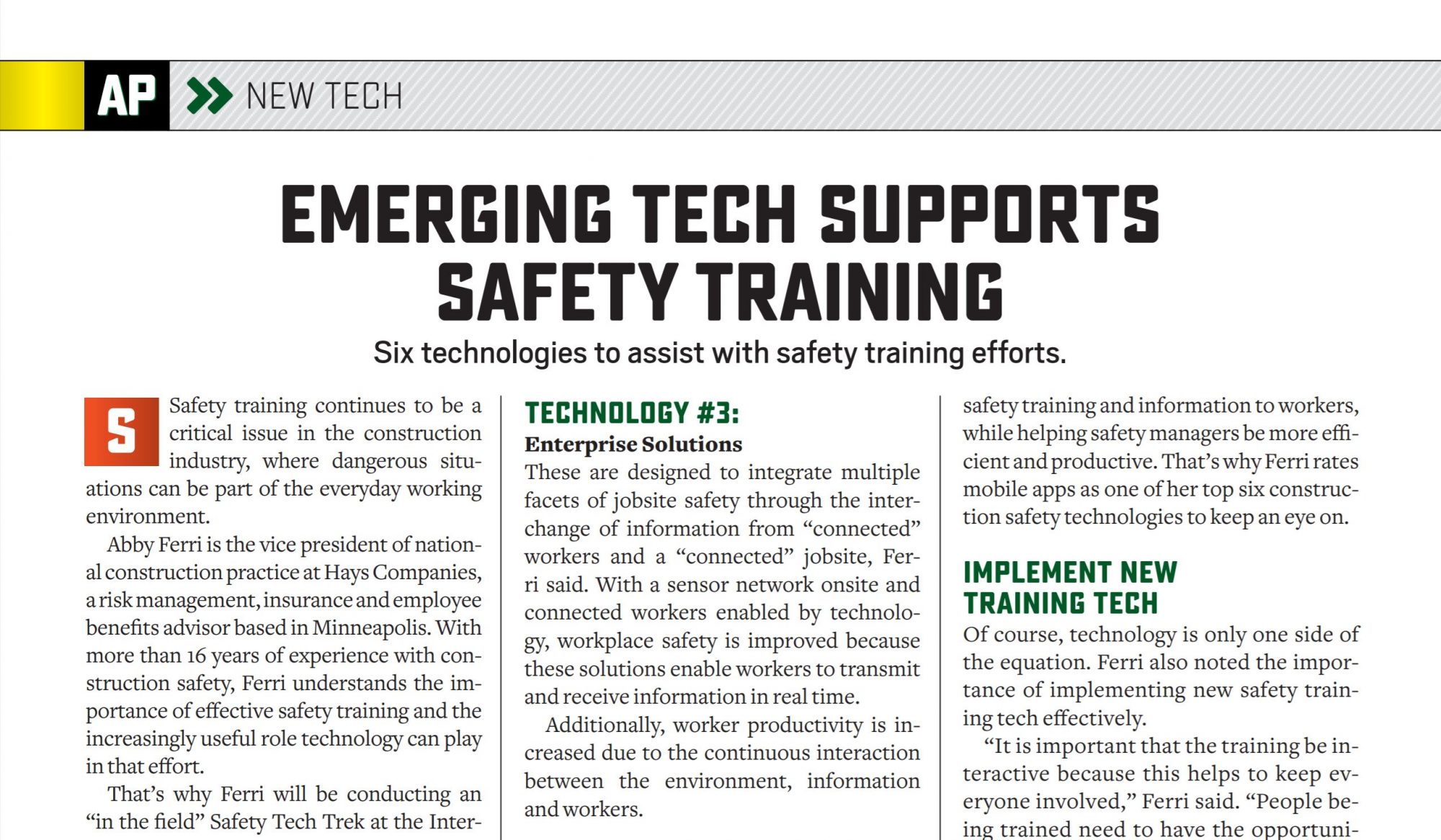Emerging Tech at ICUEE Supports Safety Training
BY Association of Equipment Manufacturers

Safety training continues to be a critical issue in the construction industry, where dangerous situations can be part of the everyday working environment.
Abby Ferri is the vice president of national construction practice at Hays Companies, a risk management, insurance and employee benefits advisor based in Minneapolis. With more than 16 years of experience with construction safety, Ferri understands the importance of effective safety training and the increasingly useful role technology can play in that effort.
That’s why Ferri will be conducting an “in the field” Safety Tech Trek at the International Construction and Utility Equipment Exposition, or ICUEE, Oct. 1 through 3, 2019, in Louisville, Kentucky. She will be walking around the show floor discussing how new equipment and technology can help keep workers safe.
Whether or not you plan to attend ICUEE, here are some of Ferri’s top construction safety technologies to keep an eye on.
Technology #1: Wearables and Embedded Technology
This technology involves attaching various types of mobile electronics and embedded sensors to the body and personal protective equipment for a wide range of purposes, Ferri said. These include proximity detection, ergonomics, fatigue, overexertion, stress level monitoring, etc. The result is improved worker and jobsite safety.
Technology #2: IoT (Internet of Things)
By combining the real-time data generated by wearables, embedded technology and GPS tracking with the IoT, Big Data can be used to monitor and measure a wide variety of safety performance metrics within the construction industry. According to Ferri, this information can then be used to continuously change and/or strengthen safety programs.
Technology #3: Enterprise Solutions
These are designed to integrate multiple facets of jobsite safety through the interchange of information from “connected” workers and a “connected” jobsite, Ferri said. With a sensor network onsite and connected workers enabled by technology, workplace safety is improved because these solutions enable workers to transmit and receive information in real time.
Additionally, worker productivity is increased due to the continuous interaction between the environment, information and workers.
Technology #4: Collision Avoidance Systems
Technologies will continue to evolve to further improve construction equipment safety, Ferri said. These include blind-spot coverage, proximity detection alerts, detecting the presence of workers, collision avoidance systems and systems that monitor equipment operators and keep a record of their performance.
Technology #5: Microlearning
Although online safety training has its place, Ferri said it may not work well for those who work in the field. Instead, she recommended microlearning.
Basically, microlearning involves breaking down information into compact, focused learning segments. The segments, usually three to five minutes long, are designed to meet a specific learning outcome, Ferri said. The training, which can be viewed on a smartphone or tablet in the field, is easier to process and knowledge retention is increased.
Technology #6: Mobile Apps
It will come as no surprise that mobile applications continue to make it easier to get safety training and information to workers, while helping safety managers be more efficient and productive. That’s why Ferri rates mobile apps as one of her top six construction safety technologies to keep an eye on.
Implement New Training Tech
Of course, technology is only one side of the equation. Ferri also noted the importance of implementing new safety training tech effectively.
“It is important that the training be interactive because this helps to keep everyone involved,” Ferri said. “People being trained need to have the opportunity to share their experiences and bring their on-the-job knowledge to the training. This is an adult learning principle that says adults benefit most from experiences that are problem based and collaborative.”
The trainer also needs to digest what is being shared, understand the group that is taking the training and, if necessary, adjust the learning activities or even the content of the training to make it appropriate and applicable, Ferri said.
“Under the lens of training, if there is technology for the sake of using technology, this may not resonate well with the workers,” Ferri said. “But technology that helps them do their jobs better, safer and more efficiently will prove beneficial.”
“Despite what some think, technology is for every company,” Ferri said. “It’s a matter of finding what technology works with a company’s culture and can supplement that culture, plus make things easier.”
You can see the latest equipment and technology for the utility and construction industries at ICUEE – The Demo Expo, Oct. 1-3, 2019, in Louisville, Kentucky. Registration is now open.
